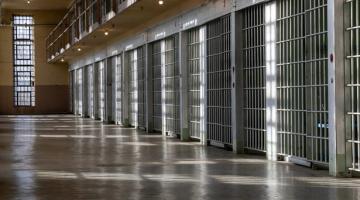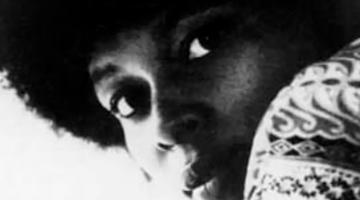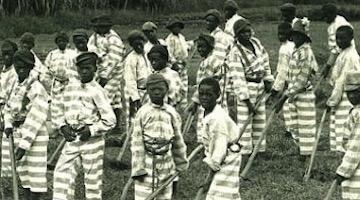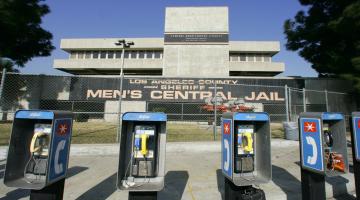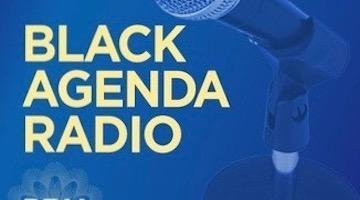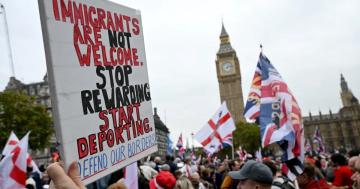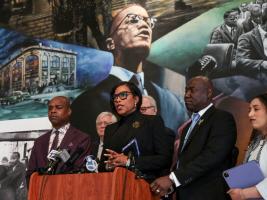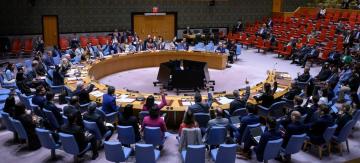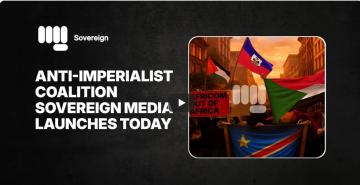By using gang laws, authorities can do an end run around First Amendment protections on freedom of association
“The push to criminalize left-wing protest groups is a bipartisan approach that has garnered support in some progressive communities.”
On July 9, Madalena McNeil bought several buckets of red paint, a ladder, and paint rollers from a Salt Lake City Home Depot store. Later that night, she accompanied two dozen other people to a demonstration outside the Salt Lake County District Attorney’s office, amidst ongoing nationwide protests over the killing of George Floyd by a Minneapolis police officer. Demonstrators shattered four windows of the office, daubed red paint on the building’s driveway, and engaged in physical altercations with the police.
Roughly a month later, McNeil was arrested on a warrant stemming from the demonstration. Along with several other people arrested, Salt Lake County District Attorney Sim Gill charged McNeil with felony charges of criminal mischief with a gang enhancement that, under Utah state law, carries a sentence of five years to life.
“I feel that it sends a very extreme message to anyone who’s considering acting out their civil right to protest, that they are going to be met with the harshest possible charges and response,” McNeil told a local television station on August 6 shortly after she was released on bail.
On August 21, a retired judge selected as “conflict counsel” by the Salt Lake County District Attorney decided to drop the gang enhancements for McNeil and her co-defendants. However, additional gang enhancement charges for other Salt Lake City protesters accused of property destruction this spring are still pending.
“It sends a very extreme message to anyone who’s considering acting out their civil right to protest.”
The use of decades-old gang laws to target participants in the largest uprising against police brutality in American history has brought criticism from civil liberties groups and criminal legal reform advocates. However, Gill is far from alone in his decision-making in the McNeil case — law enforcement in Western states have long used gang laws to target activists involved in causes including animal rights, environmentalism, and even “straight-edge” sobriety.
Many states — the majority of them in the West and South — have adopted gang laws similar to California’s STEP Act, which was enacted in 1988. This law outlawed participation in criminal street gangs and codified hefty sentencing enhancements for gang-related convictions. In recent years, gang classification and enforcement in states like California, Oregon, Illinois, and Maryland have been criticized by civil rights groups for fomenting unconstitutional and biased enforcement. In Los Angeles, a scandal involving the LAPD’s falsification of gang recordsfor dozens of people resulted in the invalidation of one quarter of the entries in the statewide CalGang database.
Mike German, a former FBI agent who spent years infiltrating and investigating white supremacist groups, told The Appeal that there is a push by the Trump administration and Attorney General Bill Barr to frame racial justice protesters and their allies as a domestic terrorism threat while eliding the increasingly lethal activities of the extreme right. “It’s ignoring reality to create a political narrative around the protests to create a particular agenda rather than address the concerns of the protests,” German said. Gang laws, German said, are an effective means for authorities to charge a number of associated people for a single offense, because the statutes function in the same manner as federal and state criminal conspiracy laws.
“There is a push by the Trump administration to frame racial justice protesters and their allies as a domestic terrorism threat.”
German said that by using gang laws to pursue alleged crimes by protesters, law enforcement authorities can do an end run around First Amendment protections on freedom of association because of the criminal status afforded to the gang. Most alarmingly, the tenor of national media coverage over the George Floyd protests — particularly an adoption of right-wing talking points around anti-fascists — means that arguments by the Trump administration are more likely to find favor in the judiciary.
“All it’s going to take is one judge to classify Antifa as a gang in one jurisdiction, and others will follow suit,” German said.
In California, local and state law enforcement have adapted the STEP Act’s investigative lens to examine political groups.
In October 2012, the San Francisco Police Department’s gang unit led an investigation into 20 demonstrators arrested during a chaotic anti-capitalist protest. The demonstration and subsequent court case came during sustained Bay Area activism as part of the Occupy and Oscar Grantmovements. SFPD spokespeople labeled the arrestees as part of a “criminal street gang” alternatively identified as anarchists or “Black Bloc,” and alleged that several people arrested also took part in the vandalizing of SFPD’s Mission station during September 2012 demonstrations over a police shooting in the neighborhood.
On the state level, California law enforcement have a similar focus on anarchist groups. In 2011, then-California Attorney General Kamala Harris’s office prominently featured “criminal anarchists” in the ‘domestic terrorism’ category of its annual “Organized Crime in California” report. The report classified anarchists along with the far-right wing sovereign citizens as the two major variations of “Anti-government Criminal Extremism.” The same report also listed animal rights activists and “eco-terrorists” like the Earth Liberation Front as domestic terrorists.
“All it’s going to take is one judge to classify Antifa as a gang in one jurisdiction, and others will follow suit.”
The push to criminalize left-wing protest groups is a bipartisan approach that has garnered support in some progressive communities. In 2017, following repeated clashes in Berkeley, California, between out-of-town far right militants and anti-fascist counter-protesters, Mayor Jesse Arreguín pushed to label the latter group as a street gang. “I think we should classify them as a gang,” said Arreguín at the time. “They come dressed in uniforms. They have weapons, almost like militia, and I think we need to think about that in terms of our law enforcement approach.”
Law enforcement in Washington State also approaches left-wing activists through the prism of gang policing and investigations. King County Jail documents provided to The Appeal by Seattle police accountability activists show the agency classified “anarchists”, the “Animal Liberation Front”, the “Earth Liberation Front”, “Skinheads Against Racial Prejudice (SHARPS)”, and “Hardline Straight Edgers” as “Predominantly Caucasian Biker, Street, and Prison Gangs” alongside the Aryan Brotherhood, the Peckerwoods and the Ku Klux Klan.
Ample evidence also shows that the federal government has several ongoing investigations into left-wing political groups around the United States. A March 2018 FBI internal communication obtained by The Appeal lists an active “Type 3 assessment” of “Anarchist Extremism” out of the Los Angeles field office under the 266H assignment code, which the FBI uses for cases they consider to be anarchist-aligned domestic terrorism. An “assessment” is an intelligence-gathering mission that does not rise to the level of a full investigation, but under the FBI’s Domestic Investigations and Operations Guide, permits the bureau to proactive scrutinize people or groups who may pose a threat to public safety without evidence of criminality.
“The federal government has several ongoing investigations into left-wing political groups around the United States.”
In August, the FBI arrested Queens resident Samuel Resto and later charged him with firebombing an unoccupied NYPD patrol car during a nighttime protest in July. According to the government’s detention memorandum for Resto, the NYPD was surveilling him when he left his apartment before the demonstration where the police car was torched. The FBI agent who swore out the affidavit for his arrest, Sarah Bernal, is assigned to the New York City Joint Terrorism Task Force. Posts on a left-wing message board claim Agent Bernal has been probing the New York City anarchist community since fall 2019.
Earlier this summer, FBI agents from the Joint Terrorism Task Force questioned people arrested during New York City’s George Floyd demonstrations about their ties to anti-fascist and anarchist groups. Although NYPD is under a decades-old consent decree that restricts the department’s ability to monitor political organizing, in recent years it has fixated on anarchist groups and events as a persistent threat, sometimes to a risible degree. New York City’s efforts against left-wing groups was part of a push by FBI Director Christopher Wray a week after the George Floyd demonstrations began instructing all 200 Joint Terrorism Task Forces across the country “to assist local law enforcement with apprehending and charging violent agitators who are hijacking peaceful protests”
On August 27, the local United States Attorney in Portland, Oregon charged 74 people with a slew of federal crimes for participating in months of often chaotic protests. President Donald Trump and Attorney General William Barr have spent much of the summer railing against“Antifa” and “Anarchists” in Portland that have faced off against local, state, and federal law enforcement in a series of clashes that drew international attention.
Josmar Trujillo, a New York City activist who studies gang statutes and policing tactics, views the application of laws usually reserved for inner-city youth of color to political activists and organizers as a targeted attempt to suppress police accountability protests.
“Cops are tired of just going and bashing heads at protests — they want you to actually pay a much deeper price. It’s one thing to get clubbed upside your head one night, then you get angrier and come back out again the next night,” Trujillo said. “They can just keep you off of the streets, keep you tied up in court spending thousands of dollars keeping yourself out of jail. That not only guarantees that you’ll be out of protests, but your circles will be out of protest, your networks will be out of protests, and people who hear about what happened to you will be dissuaded from joining.”
The Appeal is a non-profit media organization that produces news and commentary on how policy, politics, and the legal system affect America’s most vulnerable people.
Ali Winston covers law enforcement, criminal justice and surveillance. His reporting has won awards from the National Association of Black Journalists, the New York City Community Media Alliance, CUNY-John Jay and People United for a Better Life in Oakland. Originally from New York City, he is a graduate of the University of Chicago and the University of California-Berkeley.
This story was originally published by The Appeal, a nonprofit criminal justice news site.
COMMENTS?
Please join the conversation on Black Agenda Report's Facebook page at http://facebook.com/blackagendareport
Or, you can comment by emailing us at comments@blackagendareport.com

